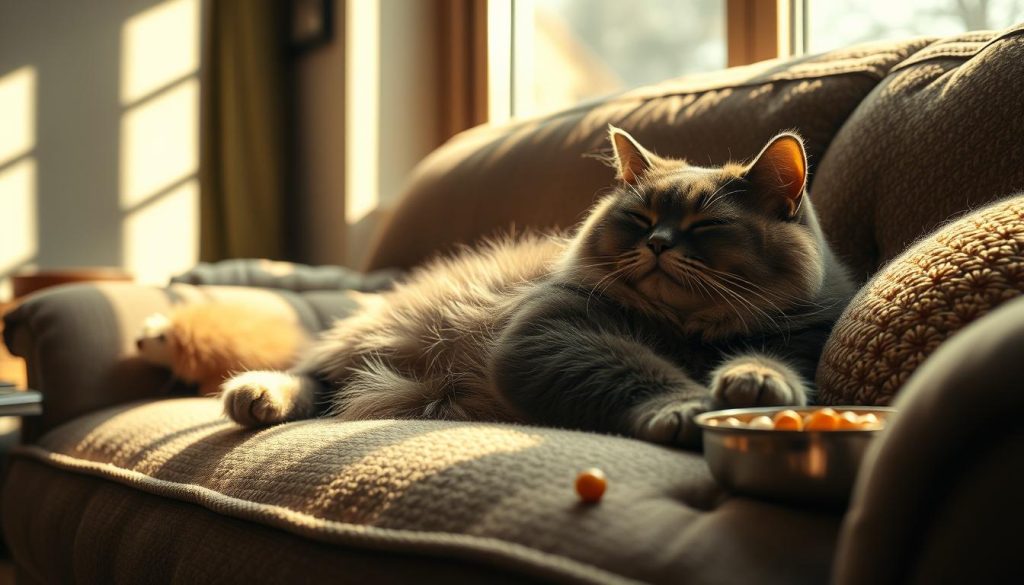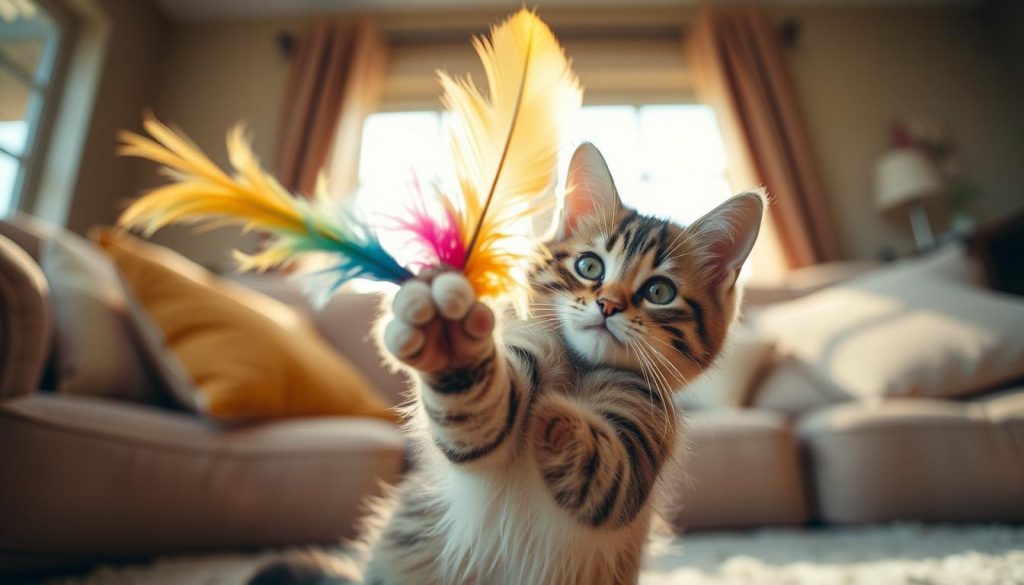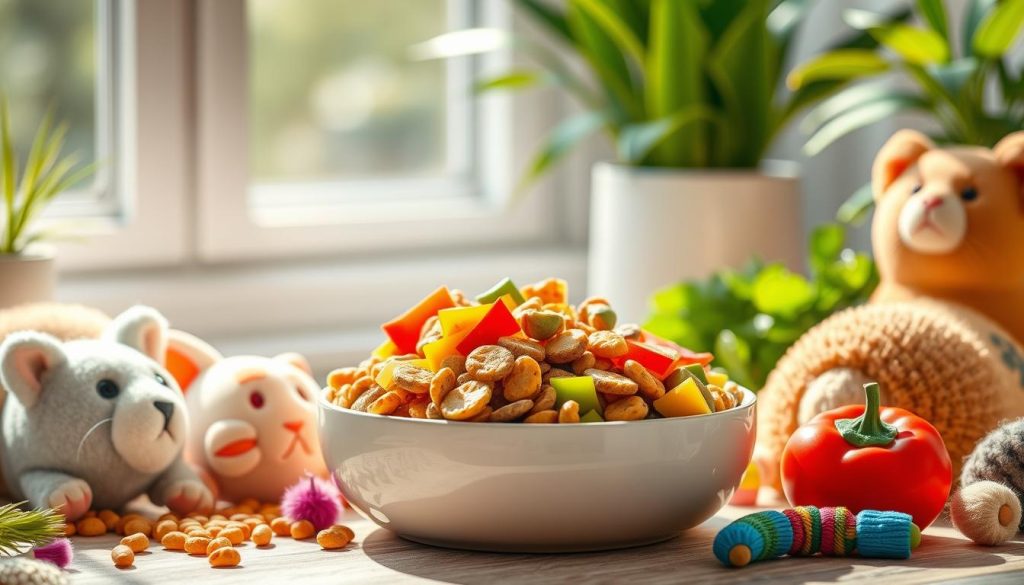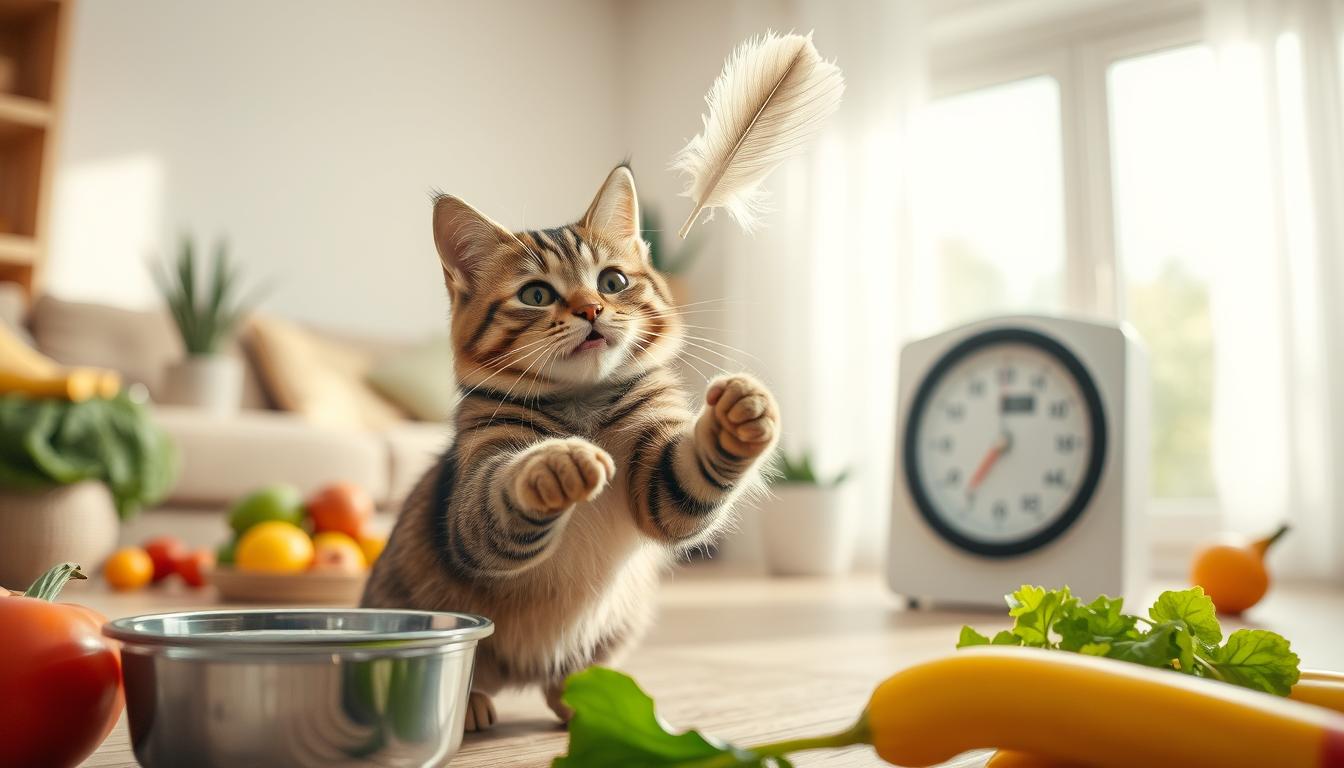As a devoted cat parent, I know how worried we get when our cats gain weight. Too much weight can cause serious health problems like joint pain and diabetes. It’s important to help our cats stay at a healthy weight.
In this article, I’ll share effective tips to help your overweight cat get fit. They’ll be happier and healthier in no time.
If your cat has always been a bit chubby or has recently gained weight, don’t worry. I’ve got the info and advice you need. We’ll look at why cats gain weight and how to change their diet and exercise routine.
By following these steps, your cat can start their weight loss journey successfully.
Understanding Your Cat’s Weight Problems
Keeping your cat at a healthy weight is key. Sadly, more cats are becoming overweight. Knowing why your cat might be gaining weight is crucial. This knowledge helps you create a plan to keep them fit.
Identifying Obesity in Cats
To tackle your cat’s weight issues, first check if they’re overweight. You can do this by feeling their body and looking for signs. Here’s what to look for:
- You should be able to feel your cat’s ribs without pressing too hard.
- Your cat’s waist should be visible when viewed from above, and their abdomen should be tucked up when viewed from the side.
- If your cat’s body shape appears round or “barrel-like,” they may be overweight or obese.
Causes of Weight Gain in Felines
Several factors can lead to cat obesity and overweight cats:
- Diet: Too much food or a diet high in calories and low in protein can cause feline weight gain.
- Lack of Exercise: Cats that don’t move enough may face cat body condition issues.
- Medical Conditions: Health problems like hypothyroidism or diabetes can also lead to weight gain in cats.
- Genetics: Some cats may be more likely to become obese due to their breed or genetics.
Understanding why your cat is gaining weight is the first step. It helps you create a good cat diet and exercise plan. This plan will help your cat stay healthy and fit.

Cat Weight Loss Tips: A Comprehensive Guide
Helping your cat lose weight is a rewarding journey for both of you. As an experienced pet owner, I’ve found that a detailed approach is essential for successful weight loss. This guide will offer practical tips to help your cat reach a healthier weight. We’ll cover diet adjustments and increasing physical activity.
Developing a Customized Cat Weight Loss Plan
Every cat is different, and their weight loss needs vary. The first step is to work with your vet to assess your cat’s health and create a personalized weight loss plan. This plan should consider your cat’s age, breed, activity level, and any health conditions.
- Determine your cat’s ideal weight range with the help of your vet.
- Set realistic weight loss goals, aiming for a gradual and sustainable approach.
- Establish a calorie-controlled diet tailored to your cat’s individual needs.
Incorporating Exercise and Enrichment
Increasing your cat’s physical activity is key to a successful weight loss plan. Regular exercise burns calories and keeps your cat mentally sharp and engaged.
- Introduce interactive playtime sessions with wand toys, laser pointers, or puzzle feeders.
- Provide vertical space, such as cat trees or shelves, to encourage climbing and jumping.
- Encourage your cat to explore and move around by creating a stimulating environment with hiding spots and scratching posts.
Remember, patience, consistency, and teamwork with your vet are crucial for a successful cat weight loss plan. By following these tips, you can help your cat achieve a healthier weight and enjoy a happier, more active life.

Adjusting Your Cat’s Diet for Weight Loss
Helping your cat reach a healthy weight is key to their happiness. Changing their diet is a big step in this journey. By picking the right food and controlling calories, you can help your cat lose weight and feel better.
Choosing the Right Cat Food
Finding the right cat food is vital for weight loss. Look for foods high in protein and made for weight loss. These foods have fewer calories and fat but still give your cat the nutrients they need.
- Read the label carefully to ensure the food meets your cat’s dietary needs, such as the appropriate protein, fat, and fiber content.
- Consider a cat food that is formulated with ingredients like lean proteins, high-fiber carbohydrates, and healthy fats to keep your cat feeling full and satisfied.
- Transition your cat to the new weight loss diet gradually to avoid any digestive upset.
| Nutrient | Ideal Range for Cat Weight Loss |
|---|---|
| Protein | 30-40% of total calories |
| Fat | 10-15% of total calories |
| Fiber | 2-5% of total calories |
Choosing a high-quality, calorie-controlled cat food and watching their intake helps them stay healthy. This supports their overall health and happiness.

Increasing Your Cat’s Physical Activity
Regular exercise is key for your cat’s weight loss. By adding structured play and a fun indoor space, you can keep your cat active. This helps them lose weight. I’ll show you how to get your cat moving more.
Start by setting aside time each day for play. Use toys like wand toys or laser pointers to get them chasing and pouncing. These games not only burn calories but also satisfy their hunting instincts, keeping their mind sharp.
Also, think about getting cat furniture like cat trees or wall perches. These let your cat climb, scratch, and explore. You can also hide treats around the house to make them search, keeping them active all day.

